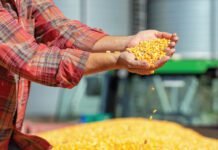Murid Ali (50), a milch cattle rearer of Bharoli Kalan village in Pathankot district, has been purchasing paddy straw from various farmers to use it as cattle fodder.
He needs paddy straw at least from 50 acres of land so that he can feed his cattle for nearly six months – from November to February and then in May and June. He says that if it is available in more quantity then he can feed this fodder to his cattle for the entire year.
Murid Ali belongs to Gujjar community (that is primarily into milch cattle rearing) and his family has been doing cattle rearing business for ages.
Another Gujjar Latif Kaka (30) of Pathankot who has 50 head of milch cattle says that he is also procuring paddy straw from about 70 acres of land to feed his bovines.
Like these two milch cattle rearers, there are around 5,000 such people in Pathankot district who are rearing from five to 70 head of cattle and almost everyone is feeding them paddy straw fodder by purchasing it from farmers at a rate of INR 4,000 to INR 5,000 per acre. From one acre they buy around 22 quintals of paddy straw.
As a result of this trend, there have been negligible cases of stubble burning in the district. This year (2022-23) there was almost zero stubble burning cases in the district because both Gujjars and farmers had been in contact with each other for selling and buying the stubble. The milk dairy owners collect it after paddy harvesting and store it for the coming months.
When asked about any harmful effect of paddy fodder on cattle, Murid Ali says, “By the grace of Almighty, my cattle have never faced any health issue after consuming paddy straw all these decades. I mix the paddy fodder with green fodder and then serve it to the cattle.”
Kaka also echoed a similar view and said that his family has been feeding paddy stubble to milch cattle even before 1947. “All my ancestors were cattle-rearers and they had fed paddy straw to their bovines for ages,” Kaka says, adding that after taking a leaf out of their book, now almost every Gujjar in Pathankot has been feeding paddy straw to their cattle for the past some years.
“Also, the Agriculture department officials have been promoting farmers to sell paddy straw to us and purchase cow dung from us in return,” Kaka said.
“On average, a healthy milch cow consumes around 22 kg fodder per day. I mix around 10 kg paddy straw fodder in 15 kg green fodder before serving it to the cattle. We also feed other minerals too to our cattle,” says Murid Ali.
“We are facing a huge shortage of paddy straw in our district because here almost every Gujjar is procuring it from farmers now who are selling paddy stubble at a rate of INR 4,000 per acre. And every year its rate is increasing because now some cardboard-making factories and a power plant have been set up close to Pathankot and they too are collecting a huge stubble now,” Kaka says, adding that this year he even went to the adjoining Gurdaspur district to purchase it.
“After meeting all the expenses of collecting from farmers’ fields, labour and transporting to our cattle sheds, paddy straw costs them around INR 500 per quintal,” says Murid Ali.
“We prefer to have paddy fodder because wheat fodder – which is considered much better – is quite expensive and cost us more than INR 1,400 per quintal,” Kaka says, adding that several Gujjars are under heavy debt due to the high cost of dry fodder and less availability of paddy straw in their district.
Murid Ali says that some Gujjars had even committed suicide due to the debt.
“The Punjab government is talking about transporting the paddy fodder to the southern states. Why can’t it transport the fodder to us as procuring paddy stubble from other districts is costing us dear and most of the milch cattle rearers are poor,” Murid Ali adds.
“In Pathankot, milch cattle rearers are playing a big role in controlling stubble burning. It is a very successful model in which cattle rearers are purchasing stubble from farmers and the farmers are getting cow dung manure in return. So the field matter – stubble – is coming back to the field in the form of cow dung manure which is very good to increase fertility and organic matter in soil,” says Deputy Commissioner Harbir Singh.
Dr Amrik Singh, former chief agriculture officer Pathankot, who was recently transferred to Gurdaspur, has been promoting this model by creating awareness among the farmers – by conducting intense campaigns, starting a YouTube channel, forming 15 WhatsApp groups of hundreds of farmers – about the harmful effects of stubble burning and how farmers can earn by selling their farm stubble, etc.
Dr Amrik Singh says that because of no stubble burning this year, the Air Quality Index (AQI) of the districts remained between 60 and 81 (lowest) which comes under “satisfactory” category during paddy harvesting, while Punjab’s AQI even shot up to “poor” and “very poor” quality for several days.
Dr Amrik Singh says that during a recent visit to Karnataka, he observed that the same model for straw management is followed in that state.
“We visited the cattle sheds of farmers who have been feeding paddy stubble to their cattle and we found no issue with their cattle which is quite encouraging for the cattle rearers,” Dr Amrik Singh adds.
The district has 1.05 lakh dairy animals and if every head of cattle is consuming 10 kg of dry fodder and 15 kg of green fodder, the district’s demand for dry fodder is over 3.50 lakh tonnes in Pathankot itself which has been producing 1.40 lakh tonnes paddy stubble from 28,500 hectares under paddy cultivation here including 2,000 hectares under basmati rice, says Dr Amrik Singh, who was instrumental in bringing stubble burning to zero in Pathankot district during his over five-year stint there.
Stubble burning has always taken a toll on human and soil health.
As per the data provided by civil surgeon Pathankot, the number of patients of chest, TB, and pulmonary diseases in children was 165, 433 and 65, respectively, in 2022-23 when compared to 198, 548 and 88, respectively, during 2021-22. The Soil Testing Laboratory, Pathankot, has concluded that an increase in soil pH, organic carbon, soil electrical conductivity (EC), and available phosphorus has been observed over the last five years.
According to a recent research report of Guru Angad Dev Veterinary and Animal Sciences University (GADVASU), Ludhiana, which was submitted to the Punjab government, the paddy straw can be used as cattle feed and it should be given only after treatment (and not directly) as it contains high silica, lignin and selenium because of which the digestive properties are reduced.
The report also mentioned that if given in moderate quantities, then selenium poses no health issue and if a mineral mixture is fed along with straw then calcium deficiency can also be controlled among cattle. Also, the GADVASU report suggested that it can be treated before giving it to cattle and mentioned urea treatment (mix 14 kg urea in 200-litre water and then spray this water on chopped straw properly and after some days it can be used) which increases its nutritional value too.
About the harmful effect of directly giving paddy straw to cattle, GADVASU officials said that there are not many studies on it but urinary calculi are associated with rice straw consumption along with some other serious health issues.
Recently Punjab Chief Secretary V K Janjua gave instructions to the officials of the Departments of Animal Husbandry, Agriculture, and Cooperation and experts of GADVASU to make a detailed plan to utilise paddy straw as animal fodder.
Experts said that in Punjab there are 65 lakh cows and buffaloes which require at least 24 million tonnes of dry fodder annually at the rate of 10 kg per day. Apart from this, there are over a lakh stray cattle and several cattle in ‘gaushalas’.
While the total production of paddy and wheat straw in Punjab is around 39 million tonnes, including 22 million tonnes of paddy and 17 million tonnes of wheat straw. In Punjab, around 10 million wheat straw is used to make dry fodder by farmers and the majority of the rest of it, which is in excess, is burnt, and some is transported to industry or incorporated in the fields. There is shortage of dry fodder in many states, and Punjab’s farmers can avail of this opportunity but with the support of government only, experts added.
Source: Indian Express













